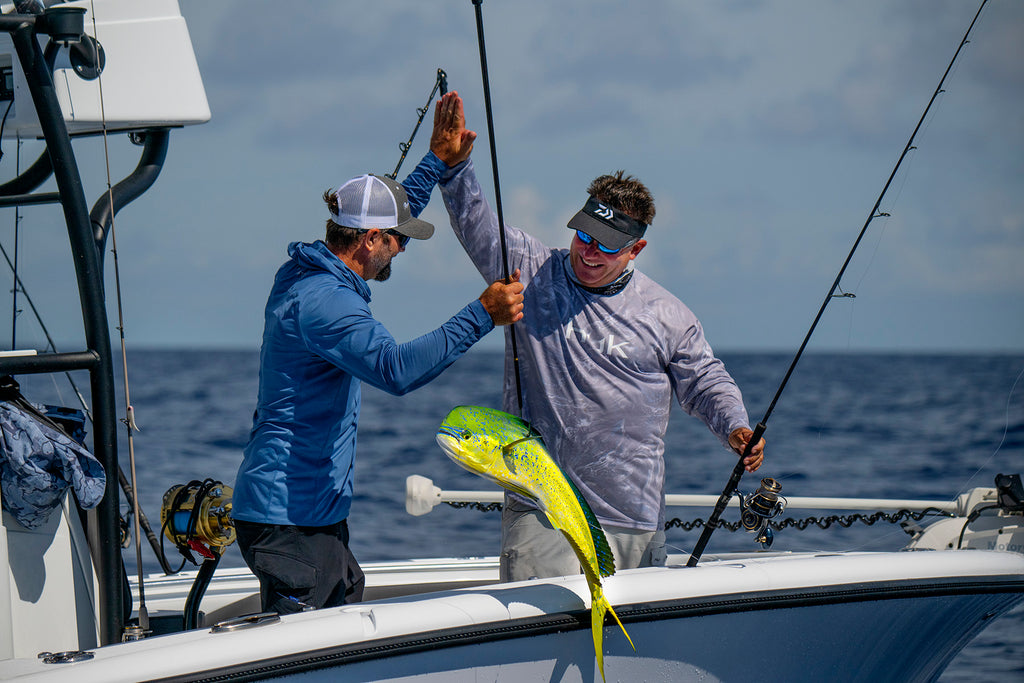Fishing Heats Up in and Around Florida’s Middle Keys
February 15, 2023

Captains Tom Rowland and Rich Tudor talk strategies for capitalizing on late-winter warming trends that bring some of the best inshore and offshore bites of the year.
PARK FALLS, Wis. (January 30, 2023) – It may still be dead of winter, but something significant started happening over a month ago. The Earth reached its tipping point. The Northern Hemisphere has been slowly tilting back towards the sun for over five weeks now, bringing increasing daylight and warming temperatures.
Located closer to the equator than any other part of the continental United States, the Florida Keys are the first part of the country to experience this warming trend.
“You may not have noticed the changes yet where you live, but our fish here in the Keys sure have,” says Captain Tom Rowland, fishing educator, communicator, and co-host of the popular Saltwater Experience television show based out of Hawks Cay Resort on Duck Key. “Our waters begin warming in January, and by February we start to experience some of our best fishing days of the year in terms of both weather and fishing quality.”
Rowland’s co-host and constant fishing partner for the past 20 years, Captain Rich Tudor, agrees. “Both offshore and inshore species really come to life in February and March, “Tudor says. “Our big tarpon are returning, permit and bonefish are sneaking back up onto the flats, the shark fishing is off the hook, and things get really exciting and productive offshore, too.”
Offshore Adventures
Rowland says February and March can be great months to target sailfish, mahi, and other pelagic species. “It’s really a great time to be offshore,” he says. “We’ve generally got favorable winds, a lot of bait, and sailfish are available and active. You can go out and hunt them exclusively, or you can set up for them while also bottom fishing for grouper and snapper. Jigging for bigger yellowtail snapper, grouper, and rainbow runners provides a lot of action this time of year, so we’ll often get a chum slick going and fish them on anchor or on a drift. Then we’ll fish a couple live goggle eyes or pilchards off a kite for the sails.”

Rowland says you don’t need heavy tackle for sailfish. In fact, he and Tudor use the same St. Croix 7’ and 7’3” medium and medium-light power Rift Salt rods for sailfish as they do for snapper and grouper – spinning models (RIFSS70MF and RIFSS73MLM) for the sails and conventional models (RIFSC70MF and RIFSC73MMF) for bottom fishing. “They (sailfish) tend to stay up on the surface and we’re typically only running 12-20-pound mono with 20 or 25-pound fluoro leaders and small circle hooks,” Rowland says. “These new Rift M and ML rods have plenty of power for the job and are a joy to fish with.”

Depending on conditions, Tudor says it isn’t uncommon to run into other pelagic species while fishing offshore in February and March as well. “You might just as easily run into some schools of mahi, blackfin tuna, or big jacks,” he says. “And these versatile, medium-power Rift salt rods are the ticket for all of them.”
Tudor drills down on his rigging for mutton and yellowtail snapper. “It’s a really great late-winter program and is super simple. You pull up over a live bottom in 120 to 250 feet of water and set out two bottom rods and a couple drift rods. We’re fishing the same medium-power 7’ and 7’3” Rift Salt conventional rods with Saltist 14 and 20 reels spooled with 40-pound braid and 30-50-pound fluoro leaders. We’re usually fishing jigs above the bottom or deboned ballyhoo or live pilchards on 3/0 circle hooks with enough weight to get down. We’ll catch a bunch and keep a couple for dinner and are always ready to pitch a bait to a passing mahi, blackfin tuna or jack crevalle. It’s a ton of fun.”

Inshore Opportunities
As good as the offshore fishing is out of the Middle Keys in February through April, Tudor and Rowland say the inshore opportunities can be just as inviting. “There’s just so many games to play depending on the conditions of the day and week,” Rowland says. “Permit and bonefish are totally in play on the right days, and we also get our biggest tarpon of the year starting to show up inshore. These are 150-200-pound fish fresh in from the open ocean and they bite well if you can find them. We’re looking for those warming days that slick off and get really nice, which makes the fish a lot easier to spot.”

Rowland says the new 7’10” medium-heavy power, moderate-fast action Rift Salt spinning rod is the ideal tool for presenting live mullet to big, happy silver kings. “It’ll load up and throw a one-pound mullet a long way, and the extra length helps keep baits separated when fishing multiple rods,” he says. “And they’re incredible fighting tools after you hook one of these big fish,” adds Rowland, who rigs simply with a 5000 to 6000-size spinning reel spooled with 20-pound braid, a 40-60-pound fluorocarbon leader terminated at a size-8/0 circle hook.”
“People see us using a lot of different St. Croix rods depending on where and how we’re fishing,” Rowland says. “These new Rift rods are the ultimate boat rods… rods that stay in the boat all the time and stand up to a tremendous amount of hard use. They’re designed for extreme durability, starting with the blanks which are SCIII carbon strengthened with St. Croix’s ART and FRS technologies. They have sturdier stainless steel and alconite guides and very durable but comfortable full-grip premium EVA handles. They also have soft, rubber gimbles that keep rigged rods from bouncing and rattling around in the rod holders. This extreme durability is why guides and so many hardcore saltwater anglers buy boat rods in the first place… they are going to get stepped on and be subjected to other unintentional abuse. But Rift rods are extraordinary in that they’re so surprisingly light and have great ergonomics so that any angler can pick them up and enjoy fishing with them. And with 28 different Rift Salt and Rift Jig spinning and conventional models to choose from, there’s a versatile Rift model to support better angling for almost any species in any situation.”

The demands on tackle don’t get any more extreme than those experienced while shark fishing, which is another favored late-winter sport enjoyed by Tudor and Rowland. “When you can’t find the big tarpon or during those times they won’t bite, shark fishing is a great option,” says Tudor, who admits he doesn’t need to use poor tarpon fishing as an opportunity to set up on a few sharks. “We’ll get big bull sharks up to 400 pounds and some really big lemon sharks, too, but blacktips up to 50 or 100 pounds are my favorite,” he says. “They’re incredible fish that jump like a tarpon and run like a bonefish.”

Tudor says chum, moving water, and a bit of patience are the keys to a fun day of shark fishing. “Sharks are scent feeders, so you want to find good current and time your fishing to the peak flow of the tide,” he says. “If the wind is pushing the same direction as the tide that’s even better. We’ll typically set up on the edge of some shallow water and hang some carcasses tied up with rope off the back of the boat… usually mahi, mackerel, or bonito carcasses we’ve kept after filleting them. It’s very visual,” Tudor adds. “We’re stationary in 2 or 4 feet of clear water and just looking for sharks who come in from downstream. We’ll usually let them get close and get a bit fired up by the slick, then we’ll pitch them almost anything on a 6/0 or 8/0 circle hook.” Tudor says they’ll use moderate-fast action, medium or medium-heavy power Rift Salt rods depending on the size of the fish. He rigs with 50-pound braid, a 60-80-pound fluorocarbon leader and a 2-foot section of #6 wire for a bite guard. “Shark fishing is always a good time, and you may get some shots at permit or barracuda, too.”
Tudor says St. Croix’s new Rift rods are the best boat rods he’s ever used. “These are versatile, affordable, absolutely phenomenal rods that will compete with any custom-built boat rod out there,” he says. “We liked the old Mojo Salt series, but these are improved across the board. They’re thinner and lighter with even more strength and power and have a beautiful look and feel. They have super high-quality guides and high-end EVA handles that are as durable as they are comfortable. They’re going to appeal to a lot of guides and boat owners who want exceptional strength, durability, power, beautiful aesthetics, and versatility without sacrifice to sensitivity or added weight… and at a very reasonable price.”
It may still look and feel like winter where you’re at, but the weather and the fishing are already hot in the Florida Keys. So, gear up and get in on some of the best saltwater fishing of the year. Don’t want to travel with one-piece Rift Salt rods? We don’t blame you. Check out St. Croix’s Avid Trek collection of 3-piece, saltwater-ready travel spinning rods. Rated for 8-17-pound line and lures from 3/8 to ¾-ounce, the 7’ and 7’6” medium-power models (ATS70MF3 and ATS76MF3) are highly versatile choices for a wide variety of saltwater species.

Keep up to date with Captains Rich and Tom by visiting their Saltwater Experience website and linking to or subscribing to their extensive content.

